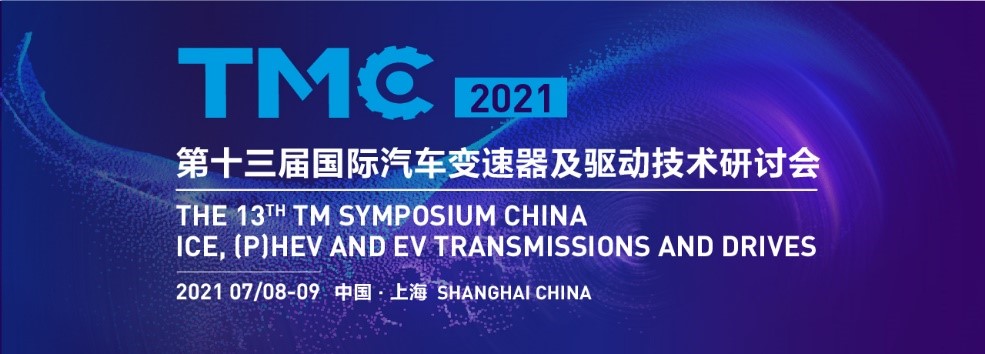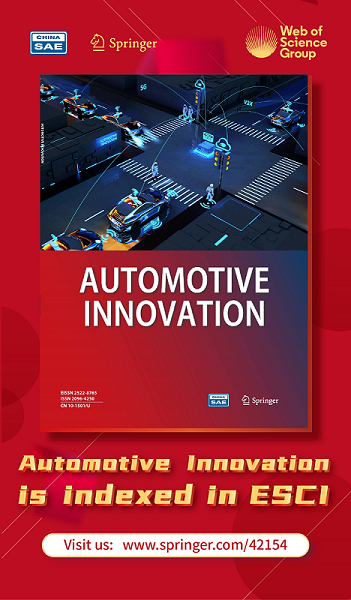

|
The journal Automotive Innovation is sponsored by China SAE, published through Springer, distributed around the world, and reflects the top-level research and technical advance of automotive engineering. Automotive Innovation newsletter in June includes the following contents: 1. A Glimpse of Experts——Prof. Jakob Andert 2. Article Recommendation——Four papers on Fuel Cell Technology 3. China SAE News: · Launch of ISC 2021 Preliminary Agenda |

 Univ.-Prof. Dr.-Ing. Jakob Andert Director of the Institute for Mechatronics in Mobile Propulsion of RWTH Aachen University, Germany |
Research Interests Hardware-in-the-Loop Simulation, Electric Motors, Predictive Control, Reinforcement Learning for powertrain control, Eco Driving and Intelligent Mobility, HCCI In-Cycle Control |
||
|
Achievements Univ.-Prof. Dr.-Ing. Jakob Andert is currently director of Director of the Institute for Mechatronics in Mobile Propulsion at RWTH Aachen University, Germany. Since 2014, he held a junior professorship in Mechatronic Systems for Combustion Engines, which was recently converted into a full professorship. His institute currently has 27 permanent employees, in the last seven years he has acquired 14 public funded projects (8 of which international collaborative projects). His research projects supported the successful excellence initiative of the RWTH Aachen University. He is spokesman of the international DFG research group FOR2401 “Optimization-Based Multiscale Control of Low-Temperature Combustion Engines”. Prof. Andert is author of 60 peer-reviewed papers and has filed twelve patents in the context of mobile propulsion. In addition to a strong focus on fundamental research, Prof. Andert collaborates intensively with the industry and has established excellent relationships with OEMs and suppliers worldwide. Besides automotive propulsion systems, his team is increasingly focusing on alternative mobility concepts, which also include novel electrified propulsion systems for boats, two-wheelers and also micromobility. |
|||
|
Quote “We are probably living in the most exciting time for all people who are fascinated by mobile drives. The disruption happening right now has incredible momentum, and I'm excited every day to do my part to make people's mobility more efficient and cleaner." |

   
|
Modifying Carbon Supports of Catalyst for the Oxygen Reduction Reaction in Vehicle PEMFCs Qiong Xue, Daijun Yang, Lei Jiang, Bing Li & Pingwen Ming |
||
| For current carbon-supported Pt catalysts in vehicle proton exchange membrane fuel cells (PEMFCs), the insufficient stability and durability of carbon supports are severe limitations under operating conditions. This paper adopts the accelerated stress test (AST) method to study the carbon corrosion of catalysts, which is significant to efficiently select the catalysts supports in fuel cells. Graphitized carbon blacks with various surface properties are heated under different conditions, followed by evaluation of their antioxidation capacity with the AST. It is shown that optimally graphitized carbon blacks demonstrate superior stability, retaining a constant quinone/hydroquinone (QH) transition peak potential for over 70,000 AST cycles. A Pt catalyst supported on the selected graphitized carbon exhibits excellent durability at both the rotating disk electrode (RDE) and membrane electrode assembly (MEA) levels. The final specific mass activity (MA) of the optimum catalyst is 47.87 mA/mgPt, which is 2.06 times that of commercial Pt/C (23.31 mA/mgPt) in the RDE tests. The final maximum power density of the optimum catalyst is 525.68 mW/cm2, which is 305.52 mW/cm2 higher than that of commercial Pt/C after undergoing the AST during the MEA measurements. These results prove that the rational surface features of carbon supports play a vital role in improving the overall fuel cell performance by realizing uniform dispersion of Pt nanoparticles, resisting corrosion, and reinforcing metal–support interactions. | |||
|
Keywords: Proton exchange membrane fuel cells · Graphitized carbon black · Oxygen reduction reaction · Durability Xue, Q., Yang, D., Jiang, L. et al. Modifying Carbon Supports of Catalyst for the Oxygen Reduction Reaction in Vehicle PEMFCs. Automot. Innov. 4, 119–130 (2021) |
|||
| Full Paper Reading>> | |||
   
|
Proton Exchange Membrane (PEM) Fuel Cells with Platinum Group Metal (PGM)-Free Cathode Lei Du, Gaixia Zhang & Shuhui Sun |
||
| Proton exchange membrane (PEM) fuel cells have gained increasing interest from academia and industry, due to its remarkable advantages including high efficiency, high energy density, high power density, and fast refueling, also because of the urgent demand for clean and renewable energy. One of the biggest challenges for PEM fuel cell technology is the high cost, attributed to the use of precious platinum group metals (PGM), e.g., Pt, particularly at cathodes where sluggish oxygen reduction reaction takes place. Two primary ways have been paved to address this cost challenge: one named low-loading PGM-based catalysts and another one is non-precious metal-based or PGM-free catalysts. Particularly for the PGM-free catalysts, tremendous efforts have been made to improve the performance and durability—milestones have been achieved in the corresponding PEM fuel cells. Even though the current status is still far from meeting the expectations. More efforts are thus required to further research and develop the desired PGM-free catalysts for cathodes in PEM fuel cells. Herein, this paper discusses the most recent progress of PGM-free catalysts and their applications in the practical membrane electrolyte assembly and PEM fuel cells. The most promising directions for future research and development are pointed out in terms of enhancing the intrinsic activity, reducing the degradation, as well as the study at the level of fuel cell stacks. | |||
|
Keywords: PEM fuel cells · Cathode · PGM-free catalysts · Performance · Stability Du, L., Zhang, G. & Sun, S. Proton Exchange Membrane (PEM) Fuel Cells with Platinum Group Metal (PGM)-Free Cathode. Automot. Innov. 4, 131–143 (2021) |
|||
| Full Paper Reading>> | |||
   
|
Cathode Design for Proton Exchange Membrane Fuel Cells in Automotive Applications Haojie Wang, Ruiqing Wang, Sheng Sui, Tai Sun, Yichang Yan & Shangfeng Du |
||
| An advanced cathode design can improve the power performance and durability of proton exchange membrane fuel cells (PEMFCs), thus reducing the stack cost of fuel cell vehicles (FCVs). Recent studies on highly active Pt alloy catalysts, short-side-chain polyfluorinated sulfonic acid (PFSA) ionomer and 3D-ordered electrodes have imparted PEMFCs with boosted power density. To achieve the compacted stack target of 6 kW/L or above for the wide commercialization of FCVs, developing available cathodes for high-power-density operation is critical for the PEMFC. However, current developments still remain extremely challenging with respect to highly active and stable catalysts in practical operation, controlled distribution of ionomer on the catalyst surface for reducing catalyst poisoning and oxygen penetration losses and 3D (three-dimensional)-ordered catalyst layers with low Knudsen diffusion losses of oxygen molecular. This review paper focuses on impacts of the cathode development on automotive fuel cell systems and concludes design directions to provide the greatest benefit. | |||
|
Keywords: Fuel cell vehicle (FCV) · Proton exchange membrane fuel cell (PEMFC) · Cathode · Mass transport · Ionomer Wang, H., Wang, R., Sui, S. et al. Cathode Design for Proton Exchange Membrane Fuel Cells in Automotive Applications. Automot. Innov. 4, 144–164 (2021) |
|||
| Full Paper Reading>> | |||
   
|
Experimental Investigation on Local Behaviors of PEMFC with Segmented Cell Yunhong Che, Aoife Foley, Moustafa El-Gindy, Xianke Lin, Xiaosong Hu & Michael Pecht |
||
| When designing a cell stack and developing an operational strategy for proton exchange membrane fuel cell, it is critical to characterize the local current, water and heat. To measure distributions of current density, relative humidity and temperature for both anode and cathode simultaneously along the straight parallel flow channels, this paper uses a segmented tool based on the multilayered printed circuit board flow field plates with embedded sensors. In this study, two kinds of experimental operations of fuel cell reactants are carried out for comparison: the co-flow operation with identical gas flow direction of hydrogen and air and the counter-flow operation with opposite gas flow directions. The detected relative humidity (RH) distributions of both anode and cathode indicate that the asymmetry of RH distribution at two sides of the membrane in counter-flow operation is better at holding water inside the fuel cell compared with the co-flow operation. The in situ measured performance distributions show that segments around the middle of the fuel cell contribute the highest current in counter-flow operation, while for co-flow operation, the current peak locates near the outlet of reactants. | |||
|
Keywords: Proton exchange membrane fuel cell · Segmented cell · Local relative humidity · Local temperature · Current distribution Yin, C., Gao, Y., Li, K. et al. Experimental Investigation on Local Behaviors of PEMFC with Segmented Cell. Automot. Innov. 4, 165–175 (2021) |
|||
| Full Paper Reading>> | |||

| Launch of ISC 2021 Preliminary Agenda | |||
 FISITA Intelligent Safety Conference China (ISC 2021) will be held in Changchun, China for a full-day event on July 16, 2021. China SAE and FISITA collaborated in establishing and delivering FISITA Intelligent Safety Conference China at a crucial time for the international automotive and mobility systems engineering community. This event delivers a high-quality, international speaker line-up, which considers and discusses the important topics of the safety of future mobility such as standards, regulation, design safety, test and evaluation, making this one of the important, must-attend events of 2021. The topics covered in ISC 2021 will be SOTIF, Cybersecurity, Impacts of Human Factors on Safety. Both physical and online conference will be held for ISC 2021, we welcome scholars and engineers around the world to participate! The preliminary agenda is now available, please click here for further information. |
|||
| Launch of TMC 2021 Preliminary Agenda | |||
 The 13th Transmission Symposium China (TMC 2021) will be held July 7-8, 2021 at Shanghai Marriott Hotel Parkview. TMC is the annual biggest gathering in automotive Transmission and Drive community in China. TMC2021 will be the event that you cannot miss if you want to see how domestic and international OEMs, transmission and drive companies would respond to the newly issued 2.0 Version of Energy Saving and New Energy Vehicle Technology Road Maps with their innovative technologies, products and modular platforms, or if you want to play a part in this community. The preliminary agenda is now available, please click here for further information. |
|||
| Automotive Innovation is Indexed in ESCI | |||
 We are delighted to announce that Automotive Innovation has been accepted for indexing in Emerging Sources Citation Index (ESCI). Articles published in Automotive Innovation after January 1, 2018 will be included in Web of Science. The quality and depth of content Web of Science offers to researchers, authors, publishers, and institutions sets it apart from other research databases. The inclusion of Automotive Innovation in ESCI is a demonstration of the journal quality, this could help improves the visibility of our content to more would-be readers. For more information, please click here. |

|
Automotive Innovation Sponsored by China SAE and published globally via Springer Nature, Automotive Innovation aims to be a world-class journal that provides abundant sources of innovative findings for automotive engineers and scientists. The journal is published quarterly, ensuring high-quality papers satisfying international standards. With the editorial board consisting of world-renowned experts, it has attracted readers from 72 countries and regions. The highest download of a single article wins more than 15,000. The journal is dedicated to the publication of peer-reviewed original papers and covers the principles, methodologies, designs, theoretical background and cutting-edge technologies in connection with the development of vehicle and mobility. The main topics include but are not limited to: energy-saving, electrification, intelligent and connected, safety and lightweight technologies. Editors-in-Chief Jun Li, Academician of CAE, President of China SAE, Professor of Tsinghua University Frank Zhao, President (2018-2020) of FISITA, President of Tsinghua Automotive Strategy Research Institute Executive Editor-in-Chief Prof. Mike Ma,Executive Chief Editor of Automotive Innovation, Professor of Jilin University, VP Technical FISITA |
||||
|
Paper submission and browse www.ChinaSAEJournal.com.cn www.springer.com/42154 Contacts: Ms. Lily Lu Tel: +86-10-50950101 Email: jai@sae-china.org |

|
|||
|
Sponsored by |
Published by
|
|||